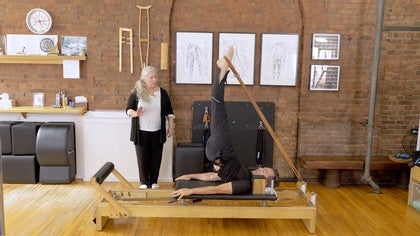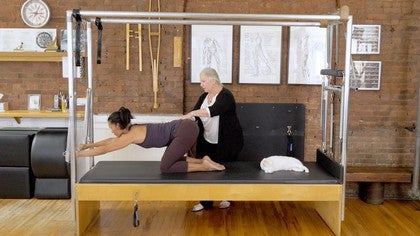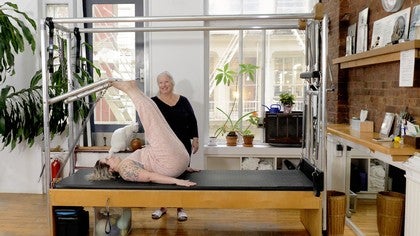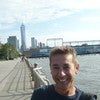Description
This video is meant for teachers to see how they can work with an advanced student. Deborah does not explain each exercise or spring tension as it is designed to be viewed rather than practiced.
About This Video
Transcript
Read Full Transcript
Hi, I'm Deborah Lessen, we're at the Green Street Studio with Peter Rowell. Peter is a very experienced teacher, former dancer, also has classes on Pilates Anytime. And he also comes to the Green Street Studio once a week for his personal workout. So we're going to do basically his regular session. And while he's moving, I'll try not to give too much of a running commentary.
So, he's going to start with a warmup that I do here. Now, Peter has studied extensively with Kathy Grant, and also with Romana, so he has different experiences with Pilates, but when he comes to the Green Street Studio, he does pretty much a workout that we have described together. Now, because he's very advanced, most of my job, I would say 98% of my job as his teacher is observation. Because he self-regulates, he knows his body really well, and I really only serve to help him if I see him start veering off the road. So really, when you're working with someone who is very advanced, if you make the tiniest increment of a correction, it's going to ricochet through the whole body.
And everything that you do. Okay, so this workout, and you notice that he started on his back doing articulation of the spine. I arrived at, over many years, to warmup the body in a way that is three-dimensional, that makes sense, that involves all of the major trunk muscles, all of the muscles around the top of the leg. And now he's starting to articulate from the top of the spine, which is incredibly important to get good thoracic movement, and good extension. So the final frontier for most people in their training is to feel where the head belongs on the spine.
Peter just corrected himself, so if you wanna see that, you can rewind your tape, and see that he started with his neck slightly flexed, and came up into a little bit of extension in line with the extension in his spine. So what Peter just finished in this position was the hundred prone, which is very important to keep enough strength in the low back and the hamstrings. Everyone really needs to do this exercise. Okay, so now we are going to change to side lying. Because to be three-dimensional in the warmup, we need to do a side lying exercise to do lateral stabilization of the spine.
So what Peter is working on now is keeping his spine literally parallel to the mat. The position that he's in is very advanced. For a beginner, you would have your underneath arm pressing up against the board, and the front arm square in front of you for support. So basically he has to support the underneath side, here, keep the top side long, and he's challenging that by moving his legs. And the pelvis has to stay square in every plane.
So he doesn't go into an under-curve or an over-curve, or a rotation. Now, we all have small lateral curves in our spine. So to some extent, everyone also needs to work on this lateral stabilization. One side will be easier than the other side, and it's my preference to start with the easier side to set the bar. I'm sorry, I'm in your way.
Good, so if you think of what your body is doing when you're walking or running, and you don't wanna be lilting from side to side, you have to do this kind of stabilization and be able to reference it in a way that works. Yeah, I think this is one of the most important exercises to do, even just lying down and bringing the legs up. Okay, excellent. All right, and now let's do your double legs. Okay, now Peter doesn't do exactly the same choreography that I do with the double legs, but he is his own mover, and I give him as much space as I can to be free and move the way he feels his body needs.
Ooh, I'm sorry. Sorry. So I love starting on the trapeze table because you have the bar system as a visual reference to center yourself on. It's like putting yourself on a grid. Good, so this series could be as simple or as energetic as you like.
Okay. All right, and now we're going to do rolling back. So if I can tell you a little bit about Peter, he is extremely hypermobile, or flexible, and so one of the things I'm always watching for when he's moving is that he keeps his body parts in proportion to each other, in relation to each other. And nothing gets that far outside the lines. Usually, you see that exhibited through the head going too far, the range of motion of the arms going too far.
And if you are hypermobile, it's difficult to feel exactly where you should be, and this is the mental part of body conditioning, that you have to intuit when you are in the line that you wish to create. Good. Okay, so come swing around, and I also wanna say that Peter's program is not the same as anybody else's program that I teach. It may generally be similar, but there are always differences because bodies are different. Different strengths, different weaknesses need different things.
So Peter, come do your parallel pull and sitting cat, first, and you can just do, you know, a couple of each. And then the side arm. So, you know, as teachers, we all go through phases where we may be very busy, we may have children, we may have other events happening in our lives where we don't have the opportunity to keep our personal practice going the way we did when we were younger. I can say, having seen Peter go through a tremendous kind of resurgence in his technique, because he works many many hours, he has a family, he's a busy guy. And a studio.
That when he comes outside of his own studio, he doesn't have the distractions that we all have with clients, phone ringing, deliveries, etc, and he can really just concentrate on himself. So we all need personal time and personal attention. And I am so excited for him that he's found excitement in moving his own body again, when literally we spend all our time trying to get our clients excited about moving. Side or kneeling? Yeah, you can do a few of your side arm.
Okay, now this exercise looks very, very simple, but actually, because the resistance is coming from the side, there's a huge challenge to keep the body vertical and keep the weight centered on two sit bones. And what he's working is his rotator cuff. But as in all Pilates exercise, you may be focusing on a particular action, but you're always integrating with the whole body. So a perfect rotator cuff with a lazy spine is not exciting. Okay, and now let's do upper arms, on your back, arms plus fingers length, not yet.
Okay. (Deborah laughs) Okay. So bend the knees. All right. So this exercise, this is a traditional Pilates exercise, exactly the way I learned it from Corolla.
This exercise is a movement sequence that embodies so many pre-Pilates principles. And when you're working on a movement sequence, you want to fulfill each movement 100%, and make a seamless transition between that movement and the next movement without overlapping, without gray area, without any lack of definition. So you know, one can learn to do an exercise beautifully, but doing it once beautifully is not enough. You have to be able to maintain that on a regular basis, and that's why Pilates is a practice, much the way we think of yoga as being a practice. Historically, with the old teachers, they would not accept you as a client unless you came minimum twice a week.
With Mr. Pilates it might even have been more than twice a week. Corolla definitely twice. Because less than that, you're not even maintaining. And to move ahead, more than twice a week is necessary. Okay, and now push through on the stomach.
Okay, so there are preparations other than what Peter is doing right now, and different bodies need different preparatory work to be able to do the whole exercise properly. So this involves extension of the spine, which is the basis of the exercise, but also excellent shoulder mechanics. Good. And it's hard to tell from watching, but he's using his abdominals to pull that push-through bar down. And keeping his lumbar spine decompressed.
Good. Good. So the regular exercise prepares rocking on the stomach. Rocking on the stomach is not an exercise unto itself, it's a continuation of push-through on the stomach. Okay, so now we're switching to the bottom springs.
Okay. All right, so now Peter's doing another rotator cuff strengthening exercise, but what he's thinking while he's doing this is keeping the length of his spine, keeping his chest and shoulders open and anchored into the mat, so that he's only straightening his arm, he's not allowing the shoulder to go forward. This is something that most adults need to work on on a regular basis. Or depressing the rib cage in order to press out against the resistance. Okay, so I think let's just do five of each of the leg work, but ordinarily we do 10 repetitions of each.
And again, I just want to emphasize that even though this looks kind of boring and pedantic, these are the nuts and bolts of your workout, you must work on your leg and foot alignment. You must be able to work the legs separately from the pelvis, which means that you have to stabilize the pelvis in the position that you want. And I want him to be in neutral pelvis. I remember Kathy talking on the plié, the bending, to push her hands, instead of letting the pelvis come up, to push your pelvis into her hands. That is so interesting, so she inadvertently was talking about neutral pelvis without a title.
That's wonderful to know. So can I just ask you to do this poorly and depress your rib cage? Okay, so we want him to be able to support his lumbar spine and use his arms to press up against the resistance, not take it into the torso. So every muscle has its job to do. Okay.
All right, thank you. Okay, so I want to mention that depending on what issues your body or your client's body may have, any number of these exercises may be inappropriate for your client. So learning and knowing any repertoire is step number one. But then you have to learn how to adapt to each individual body. And I don't believe in levels, beginner, intermediate, and advanced, because people may be advanced in some ways and very much intermediate or maybe even beginner in other ways, depending on their body.
So you have to find the appropriate challenge point for every coordination. Get out of the way, teacher. (laughs) Good. Okay, and let's go right into tower. Okay so I hope that you don't watch this video and think that this is the workout for you, or the workout for any particular person.
You have to learn each piece, you have to embody these exercises and really know them in your body. And some may be easy, some may be difficult. Good, now I know that Peter learned this exercise differently than he's performing right now, so where I have limited his movement is on his plié, here. Because if you drop your legs way down, you're dropping down into your spine, and you have all that pressure in your knees. So I'm very specific in wanting you to hold the weight of the resistance in your hamstrings when you're in the inversion.
Any inversion, you wanna be using your arms and legs to help support the body so that you don't have that downward pressure through your spine. Good. Okay, and now let's do parakeet. Okay. So this particular exercise, Peter does his warmup into it.
I give him total run to do what he feels is right for his body, and then he does some much more challenging stuff at the end. So this actually is a reverse monkey. And that's a Kathy, as well. Or at least I got it from. Yes, and I believe Kathy also did this sometimes with no spring, which is really murder.
(chuckles) Okay, thank you, Peter, that was beautiful. And now we will move onto the reformer. Okay, and he's going to do coordination first, and I do coordination as a warmup for the hundred. So I use this actually for my new clients to teach them where their spine is. So now he's in neutral, he goes into flexion for the movement, and then he goes back to neutral at the end.
So I want them to know specifically when they do the hundred that they're in full spinal flexion. Okay, now you'll notice that Peter is doing some leg movements, he's not doing this because he's bored, and he's not doing it because I'm bored, because I love watching him move. He's doing this to challenge himself. And mainly to see if my hips can stay in place in all three planes, instead of going all over the place. Good, and now we go right into jack knife.
Good, so if, as a teacher, you have not done an assisted jack knife, don't learn on your clients. Learn on another teacher that can tell you immediately if you're pushing too hard, if you're pulling them out of position, you need feedback, you need to learn the feel, and you need to do it on many different bodies before you start working with clients. Good. Okay, and now we go up on the box. So in Corolla's sequence, you did all the long box exercises first.
Then you did short box exercises, and that was it. You only put the box on once. So there was as minimal spring changing and equipment changing as possible. So now Peter's doing pulling straps, and I want you to look at this exercise and see how it is described by the movement of the spine. When you are thinking of the primary intent of an exercise, start with the spine.
So of course there's shoulder stabilization, and I, particularly because he's so hyper-flexible, wanna make sure that he doesn't over-flex his back. That he keeps weight on the bottom ribs, so from his mid-thoracic spine to his tailbone, he's not crunching. Okay, and now we move onto T. Now, I fortunately get to work with many teachers who have trained in many different places, and I do notice some wild ranges of motions. I want you to think of your Pilates practice as being in your safe zone.
So you're always floating in the middle of a joint. When you go into an extreme range of motion, you're going way beyond that. If you are a dancer or an athlete, and you have to perform when you're injured, you need to know exactly where you can pull back so that you can move safely. And that's what you learn in your Pilates practice. Okay, so now Peter's doing backstroke swimming.
Good, so again, this is a full spinal flexion exercise, just like coordination and hundred, the pelvis is in a posterior tilt. So if you over-flex at one end, you're going to under-flex at the other end, you have to think of the whole. Okay, and now we go into teaser. Now this is not the way I learned teaser, but this is a wonderful challenge for Peter, and it's a marvel to watch him. Beautiful.
Okay, now, he's just done two flexion exercises, so now we're going back to extension, and we wanna make sure that we don't burn out moving in one way, so you have to keep changing it up. Okay, so now Peter is going to do swan. I'll help you. Okay. Okay, now, Corolla's version is different than most people do, so we're going to start straight legs, one long line for the whole body.
So this is the starting position. No, Peter, stretch? Yeah, so you're gonna go up right from here. Inhale, lift. Open.
Exhale, roll forward, Inhale roll up, center the head, dive under, and stretch. Good, inhale rise up, up and open, exhale roll forward, roll back up, center the spine in a vertical line, and then dive under and stretch once more. Inhale, up and open, exhale. Good. Center, dive under, and stretch.
Good, okay. All right, and let's move onto stomach control. Okay. All right, so, stomach control is a full flexion exercise, the spine stays in flexion the entire time, and Peter likes to do this exercise and go directly into climb a tree. Good, and actually you wanna do twist first?
So notice as Peter rolls back, the lowest point of the curve is his low back. Once you go lower than that, you're going to start reversing your lumbar curve. And you literally want to be supporting your body weight with your abdominals. And flat back first? Sure.
Okay. So this is a weighted ball. So since this is a lot of weight, relative, I'm building up the amount of weight that goes back. Good, and notice that the knees are bent for flat back, because you're in a hip flexor, back extensor pattern. Whereas round back, you're in a hamstring abdominal pattern.
So I like to put my hand to activate my inner thigh and pull my straight leg hip back, so I stay more placed and stable when I do leg. My right hip pulls back to go back, and then I climb down. Pull that hip back to go down. So one wouldn't think it of this exercise, but the hardest part of the exercise is keeping the pelvis centered. I'm sure if you've tried this and you have scoliosis, you've figured it out.
Okay, and now let's do sides. Sorry. (Deborah laughs) All right, now if you remember the side stabilization that Peter did in his warmup, he's referencing that here. So he doesn't come up into a giant side bend, he comes up so that he's parallel to the floor. Right, so we want the two sides of the body equal in length.
And then he rotates around the spine. And what I'm trying to do is to initiate for my middle back, and my middle back, and keep this hip forward when you twist. So when I watch Peter moving and I see him trying different things, I want to try to figure out what his strategy is, and is that strategy working? If it is, there's no reason for me to say anything to him. Good.
Okay, breast stroke. All right, so let me change you to one spring. Excuse me. Okay. Good, so, when Peter comes up, he's coming up in one straight line.
Now I'm sure you've seen, it's all over the internet people doing this without an assist, just arching their back and coming up, which is a lovely movement, but it's not the same as this. We have a wonderful old photograph of Kathy Grant assisting Corolla doing this exercise, and you can see her body straight as a piece of steel, as she used to say. And now, Peter's going to do arabesque, another exercise from Corolla's. Okay. Good, okay.
This is a smaller reformer than Peter is used to working on. That's why I'm a little nervous (laughs) but so far so good. Good. Actually Peter, grab your feet here, and just do a couple little rocks on the stomach. So this is rocking on the stomach, and he's on one spring.
It's very small, but it's challenging and a wonderful stretch. Good. Okay. All right, so box be gone. At this point, we would do footwork, but I think let's skip footwork, but just know that he would be doing both double legs and single legs, 10 repetitions in each position.
Shall we go through the positions? We could do that, good idea. Okay, so let's just indicate with two springs on, because that's what we'll use after this, okay. So, double legs, the first position is toes apart, heels together, and you place your weight on the fifth metatarsal. The knees are only as wide as your ribcage, so that you incorporate the inner thigh in your leg work.
The second position is parallel, toes and heels together. And the knees always are slightly separated so that you are rotating and screwing the femur back into the hip joint. The third position is up on the heels with the feet together. And then tendon stretch, back down on the balls of the feet, parallel, yes. Correct, okay.
Or you could do running, or both, in this position. And then finally, heels wide, turned out. And the turnout all happens from the top of the leg, not from the feet. Because if you move from the feet, you're going to twist the knee. Good, okay.
Now, single legs, there are only three positions. So first you would be doing ball of the foot, just plain, extend, and bend. So you do both sides, then come up on the heel, same thing, and this is hip-width apart. And the reason you have to be open is so that you counter-stabilize in your torso. And then the third set is single leg tendon stretch.
So you do come in in between, whereas double legs is just flex and point with straight legs. Good. Now, footwork is time consuming, but it is so important, we have to keep working on leg alignment all the time. Our legs support us in our standing posture, so if your legs are off, your pelvis is off, your spine is off. And then off with your head.
Okay, so let's go right into spinals, short spine first. Okay, now we did this slightly differently at Corolla's, which Peter will show you, so as he rolls over, he's going to keep his hips down on the mat as long as he can. This is full hamstring stretch, then that whole shape goes over upside down. Drop the knees, good. So he is using his abdominals and his arms, pull the tail down first and then pull the heels down to the sit bones.
Good, stretch. Good, you wanna let the legs pass close to your face. Good, so this is like roll over in the mat work. Good, once more. Good, and now we go directly into crab.
Peter has an enormous range of motion. Be careful if you try this on your own. Keep the tailbone really heavy into the floor and the ribcage in so you're stabilized in the lower back and you don't get hurt. Okay, and now right into long spine. Okay, so this is also slightly different in the Corolla repertoire, that you keep your legs absolutely vertical the whole time.
And the legs only open as wide as the ribcage. If you get too wide, you lose control in the trunk. Good. Okay, and now we go onto the standing series. Now Peter is doing kneeling knee stretches first.
I would say if there's one exercise that epitomizes Pilates for me, this is it. Good, and now standing knees, and this is different than you may have seen, because we want the hip joint and the shoulder joint the same distance from the floor so that he's buoyed up from underneath, his chest is deep, his abdomen is deep, and he's opening his low back. Now, the single leg is challenging, also, to keep your pelvis centered. So you wanna keep your sit bones even, and you wanna avoid the pelvis rotating. Good, right hip just a hare higher, yeah.
Good. Okay, control front. Good, now, this is actually a small range of motion. If Peter were to push too far forward, you would see his spine start to flex, here. So you have to stay into the shoulder socket.
Now in the tendon stretch, bring the legs forward, that's why your buttocks come down. So that's more of a teaser feeling that a shifting of weight, you know? So you wanna not go back, but you wanna bring the legs forward, here, and then you come down. It's like a jack knife. Yeah.
So you get it here. Elephant? L'éléphant. Good. Good, so when you switch to single leg, you still want the spine to stay right down the center of the platform.
Don't shift your weight over the standing leg, work on the inside of the standing leg. This helps strengthen you for standing work. Okay. Up stretch, down stretch, if you need grips, I'll get them. (indistinguishable speech) Okay.
Okay, so this is a combination of up stretch and down stretch, which is very challenging. Good, and the most important thing is to stay deep in the abdominals and keep that lumbar spine long and decompressed. (car horns honking) By the way, we're in the middle of Manhattan, and as usual, there's lots of noise coming from the street, just ignore it. Good, round, head way under. It's all those people dying to get in for a Pilates session, must be.
Good, good, good. Okay, rowing? Rowing? Just like a couple of each? Okay, so this is the way we did rowing back at Corolla's.
It's extremely challenging and, mind you, Peter's on two heavy springs. So as you watch this, think of the mat exercise boomerang. It's very similar in feeling, only you're moving against a lot of resistance. Especially when I came to Deborah and I did this the first time, I was furious with this exercise because it's so heavy. But then you really need the heaviness to actually feel this happening.
If you do this on one spring, you'll fall backwards. Yes, and that's an excellent point, different movements need different amounts of resistance, you always have to find the appropriate resistance for what you're doing. And it's the same, actually, with the long box on the two heavy springs. It's more about the body lengthening forward and up instead of an arm movement going back. So it's a whole different intent.
So if we dropped the spring weight down for this, Peter could do a larger movement, but the reason that he's doing it is to strengthen his mid-back and the posterior shoulder, so it really would not benefit him that much to do a greater range of motion. Good. So you can see how clean Peter's movement is. And this is something that develops over a period of time, that's why Pilates is a practice. It's one thing to come once a week or once a month and try to perform exercises, it's another thing to be able to perform them at a high level on a consistent basis.
And that's when you really reap the benefits. Plus, we don't feel the same every day. Our energy is different, our... Muscles feel different, and you have to be able to assess how your body is that day, and work with it the best you can. Yes.
Okay. Semi? Semi-circles, yeah. So from spinals up until now, Peter's been on two springs the entire time. And believe me, the less you have to get up and move the equipment around, the better, because that just interrupts the flow of your workout.
A little stretch. Okay. Good. Okay, so let's do Corolla's split, and let's do it with this today. No.
(laughs) Yeah. Yeah. This is a shorter reformer than you're used to. Good, and zip. Good, now if you look at Peter in this moment up here, his shoulders come, stay back a little bit, just come forward through your chest slightly, stretch that back leg back, good.
That's it. So the shoulders are right over the hips, his torso is right between the legs. Now center and plié, and lift, good. Good. May I?
So of course there are a number of other splits, there are many other exercises to do, and I would say that at Corolla's, you basically did the same program, and perhaps varied a few exercises at the end. So one day you might wanna do more splits, one day you might wanna go to the bar and do some standing work, whatever it is that you want. But, you're not constantly changing the basic program. That's your vehicle for creating your technique. Okay, so now Peter is going to finish his session with rolling on the spine corrector, and I just want to set up his position so that you see, with the arms vertical, that the palms face each other.
So he's outward rotated at the top of the arm, the outer edge of his shoulder blade is coming around his back. So we don't wanna adduct the shoulder blades. Good, and now he's stabilized in his shoulder girdle, and he can really articulate through the spine. Now here's a danger point, we don't want him to drop out of that engagement in his shoulder socket. Good, and actually, he's got balls in his hands, and if he presses his little fingers against the balls, he can feel that line of energy from the little finger all the way down to the bottom outer corner of the shoulder blade.
Good, so you wanna keep the upper back nice and wide. Good, and now second position, so the arms are just carried on the back. And he's going from second position to fifth position, he's not letting the arms go behind the body. Basically, you should always see your arms, or your hands, in your peripheral vision. And you're going to need your shoulder blades right now.
(grunts) (Deborah chuckles) So Peter, again, is using this weighted ball, which is very challenging. So Peter, that was wonderful. Thank you. Thank you so much. Thank you.
(kissing noises) Okay, thank you. Thank you.
The Teacher's Corner: Always a Student
Comments
You need to be a subscriber to post a comment.
Please Log In or Create an Account to start your free trial.




























